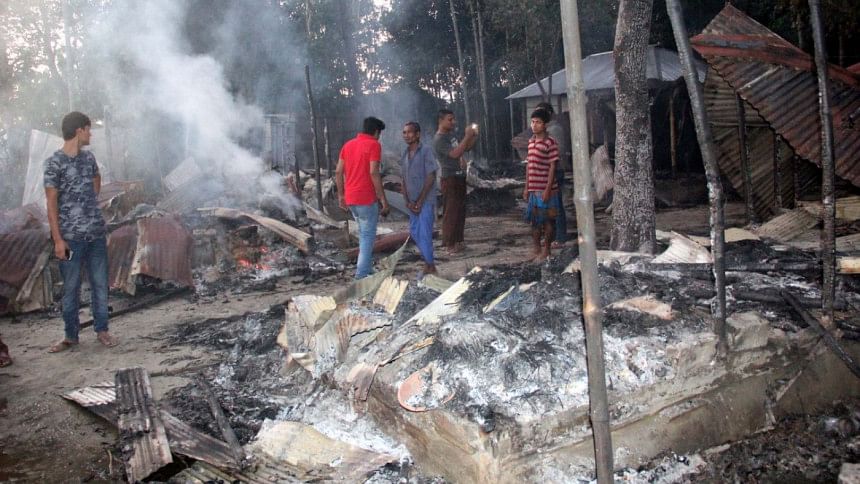The psychology behind communal attacks

Bullying is an interesting, unique and complex form of interpersonal aggression. It is a distinctive pattern of harming and humiliating others, especially those who are in some way smaller, weaker, younger or in any way more vulnerable than the bully. Experts such as Brenda Morrison, Assistant Professor, School of Criminology, Simon Fraser University, insist that bullying is mostly about power and control at all levels of analysis and across all social domains.
It is a deliberate and repeated attempt to cause harm to others of lesser power. It's a very resilient behavioural style, mainly because bullies get what they want.
On Friday, November 10, at least 30 Hindu houses were burned and vandalised by a mob at Thakurpara village under Rangpur district over a Facebook post allegedly "demeaning Islam". On the night of November 4, hundreds of people gathered in front of Paglapeer Mosque in Rangpur Sadar for bringing out a procession demanding the death penalty for the accused Titu Chandra Roy for his alleged Facebook post. Around 10,000 to 12,000 people, from Badarganj, Gangachara and Taraganj upazilas of Rangpur and Jaldhaka of Nilphamari, carrying sticks and brickbats, gathered in the area. Later they marched towards Horkoli Thakurpara village, around one kilometre off Soleya Shah Bazaar.
Around this time last year, a New York Times report quoted police officials saying that four other similar episodes were recorded in Madhabpur where crowds ransacked four Hindu temples and households. And the day after, gold jewellery and cash left by worshippers at a Hindu festival were stolen from a temple in Chittagong. Another confrontation occurred in the northeastern town of Chhatak the same day where several Muslim men converged at a mosque near a Hindu temple, and pelted it with stones.
Am I the only one who is feeling a sense of déjà vu? Last year, a synchronised attack was carried out on the Hindus in Brahmanbaria's Nasirnagar upazila, vandalising around 100 homes and at least five temples and looting valuables over a Facebook post "hurting Muslims' sentiment." The attackers also beat up over a hundred people of the minority community and ran through eight Hindu localities, including Kashipara, Daspara, Ghoshpara, Duttapara and Nomoshudropara.
The then Superintendent of Police at Brahmanbaria was quoted by The Daily Star as saying that around 150 to 200 locals attacked five temples in Nasirnagar upazila and vandalised seven to eight idols and homes and injured two people. As the news of the Facebook post spread, violence spilled over to the neighbouring Habiganj district where a Hindu temple in Madhabpur bus stand area came under attack.
The mayhem in Brahmanbaria also began with a Facebook post—a doctored photograph that shows an idol of a Hindu deity on the picture of the most revered place of pilgrimage for Muslims — supposedly published from the account of Rasraj Das. Much similar to an incident in Cox's Bazar's Ramu in September 2012, when the Buddhist community was attacked, following a claim that a Buddhist youth had insulted Islam on Facebook.
While the mysteries surrounding the most recent incident are yet to be unravelled, an investigation by The Daily Star on the Brahmanbaria attack later found the Facebook post was faked to justify the violence. In case of the most recent event in Thakurpara, Titu was arrested last week. Primary investigation on the part of the police had found that the Facebook post was uploaded from somewhere in Rangpur's Gangachhara from the account of an individual named Md Titu on October 28. Ziton Bala, Titu's mother, and locals said Titu could not read and write and they did not believe that he could create or upload the post. Also according to them, Titu lived in Narayanganj and he had never visited that village in the last four to five years.
In all of the above-mentioned cases, a term that was frequently used to speak about those who carried out the attacks is "zealot". Incidentally, it is one of my favourite words in the English vocabulary. I like it because of the range it offers. The term "zealot" means one who is zealous on behalf of one's Creator. The term derives from Greek (zelotes), "emulator, zealous admirer or follower." However, it took on stronger religious connotation in the 1st century when during a political movement which sought to incite the people of Judaea Province to rebel against the Roman Empire, "zealotry" was the term used by Josephus for a "fourth sect" or "fourth Jewish philosophy" during this period.
It's interesting because, while it is a term that is presently laden with negative connotation, it probably wasn't when initially coined. Zeal could be, and often is, a good thing. Being zealous isn't necessarily problematic either. However, when zeal spills over into acts of aggression and violence, particularly in situations where there is no reason to feel threatened on account of one's faith, it's time to ask yourself, when you are engaging in acts such as this, are you really acting on behalf of your belief? Or are you acting to justify having power over a people?
Acts such as the above-mentioned ones are not acts of zeal. When a majority group, i.e. ones with power, wreaks havoc on the lives of a minority group, i.e. the ones with less power, the act is about domination, a demonstration of power. By virtue of humiliating and harming those who are perceived to be weaker, smaller, on a micro level, these are acts of bullying.
There are several theories about why people bully. Traditional models of power and conflict have theorised that conflict creates a situation where the personal power of one actor over another is sought and increased through bullying behaviours. What is conflict and whether or not it is conflict that is causing an uneven power dynamic or the uneven power dynamic that is causing conflict are things to ponder.
Maybe the underlying conflict embedded decades ago during colonial times manifests today in various violent incidents. Or maybe conflict is deliberately kept alive. Some theories indicate that bullies may act out of low self-esteem, wanting to improve their social status, or feelings of anger or frustration. So, maybe we are so insecure about our faith that it feels like a part of us is always under attack. Maybe it is a combination of things that drive this behaviour. I have yet to understand.
But part of the act of bullying results from a desire to dominate others and having a lack of remorse or failing to recognise this behaviour as a problem. So let us begin by recognising this behaviour as a problem. Let us first understand that there is nothing zealous or glorious about burning homes, temples, lives. Let us recognise that we are feeding our egos, not answering to some divine calling. We are being bullies, who carry out harmful acts in an unequal power spectrum, to validate power over instead of engaging in dynamics that facilitate power with.
It is those women and men who are pulling the victims into shelters, opening their homes, holding their hands forming human chains to protest against atrocities committed against their neighbours, who are zealous. It is the ones who act out of kindness, who act on behalf of their belief. Or at least, that is the way I see it.
Shagufe Hossain is the founder of Leaping Boundaries and a member of the editorial team at The Daily Star.

 For all latest news, follow The Daily Star's Google News channel.
For all latest news, follow The Daily Star's Google News channel. 



Comments